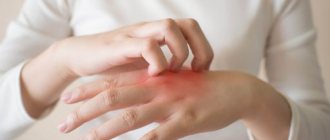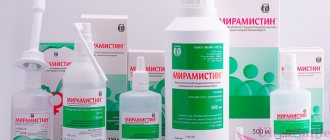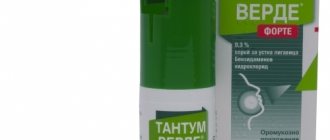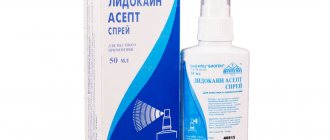Sexually transmitted diseases are a group of infectious diseases that are transmitted primarily through sexual contact.
The causative agents can be various groups of microorganisms: protozoa, bacteria, viruses.
To combat them, antiseptics are used, which are applied topically.
Miramistin is one of these drugs.
Since the drug is active against STIs, it is used in venereological practice externally at the site of the lesion.
Properties of Miramistin
The main active ingredient is benzyldimethyl.
The mechanism of action of the substance is based on the destruction of the cell wall of pathogens.
But the epithelial cells of the urogenital tract are not exposed to the negative effects of Miramistin.
This property allows it to be successfully used in venereology.
The antiseptic is used not only for the treatment of urogenital infectious diseases, but also in other areas of medicine.
The drug has an antimicrobial effect against protozoa, bacterial microflora, fungi, and viruses.
Miramistin is able to cope with HIV and the herpes virus.
The drug is effective even against strains of bacteria that are resistant to antibiotics.
Because of this property, it is used for preventive and sometimes medicinal purposes.
Among the advantages of the drug:
- It should be noted that there is no irritating effect. The product does not cause chemical burns, discomfort in the form of tingling or burning sensation. Patients easily tolerate treatment. If there are ulcerations or erosions on the mucous membrane, then the use of Miramistin in no way affects the ability of tissues to regenerate.
- Lack of ability to penetrate deeply into tissues and into the systemic circulation, even when used in large quantities. As a result, there are no side effects, which ensures the safety of the drug.
Studies have found that the drug is highly effective if used in conjunction with antibacterial agents.
In combination with antibiotics, Miramistin has a stronger effect.
Miramistin
Miramistin is an antiseptic drug for local and external use. Endowed with a wide spectrum of antibacterial action, including nosocomial microbial strains resistant to antibiotics. The drug has a pronounced bactericidal (destructive for bacteria) effect on gram-positive (Staphylococcus spp., Streptococcus spp.) and gram-negative (Escherichia coli, Klebsiella spp., Pseudomonas aeruginosa) bacteria. It has a fungicidal effect on ascomycetes of the genera Penicillium and Aspergillus, yeast (Torulopsis gabrata, Rhodotorula rubra) and yeast-like (Candida albicans, Candida krusei, Candida tropicalis, Malassezia furfur, Pityrosporum orbiculare) fungi, dermatophytes (Epidermophyton Kaufman-Wolf, Epidermophyton floccosum, Microsporum canis , Microsporum gypseum, Trichophyton mentagrophytes, Trichophyton rubrum, Trichophyton schoenleini, Trichophyton violacent, Trichophyton verrucosum) and other monocultures and associations of pathogenic fungi, including fungal microflora with resistance to chemotherapy drugs. It has antiviral activity against complex viruses (human immunodeficiency virus, herpes viruses, etc.). The drug also acts on pathogens of sexually transmitted infections (Neisseria gonorrhoeae, Chlamydia spp., Trichomonas vaginalis, Treponema spp., etc.). Effectively prevents infections of burns and open wounds. Stimulates recovery processes. Activates the occurrence of protective reactions at the site of direct use due to the activation of phagocytosis. The presence of pronounced hyperosmolar activity in Miramistin gives the drug a number of useful properties. Thus, this antiseptic is able to reduce wound and peri-wound inflammation, absorb purulent exudate, promoting the formation of a dry scab. At the same time, miramistin does not damage granulations and normal skin cells, and also does not suppress marginal epithelialization. The drug does not have irritant or allergen properties. When used topically, Miramistin is not absorbed by the skin and mucous membranes and does not enter the systemic circulation.
When used in traumatology, combustiology, surgery for therapeutic and prophylactic purposes, wound and burn surfaces are irrigated, wounds and fistula tracts are tamponed, and gauze swabs soaked in miramistin are secured. This procedure is carried out 2-3 times a day for 3-5 days. One of the most effective is the method of active drainage of wounds with a daily consumption of the drug up to 1 liter. When used in obstetric and gynecological practice, in order to prevent postpartum infection, vaginal irrigation is performed for 5-7 days before childbirth and in the postpartum period. The consumption of the drug for one such procedure is 50 ml, the exposure time is 2 hours. If the birth took place by cesarean section, then immediately before the surgical intervention the vagina is treated, during the procedure the uterine cavity is treated along with the incision made, and after the operation tampons moistened with miramistin are inserted into the vagina for 2 hours every day for 1 week. Treatment of diseases of inflammatory origin is carried out in the form of two-week courses by introducing tampons into the vagina and/or through medicinal electrophoresis. To prevent sexually transmitted diseases, Miramistin will be effective if it is used no later than 2 hours after sexual intercourse. To do this, using the included urological applicator, the contents of the bottle are introduced into the urethra for 2-3 minutes: 2-3 ml (for men), 1-2 ml and an additional 5-10 ml into the vagina (for women). The skin of the inner thighs, peripubic area and external genitalia is also treated. After this procedure, it is recommended to refrain from urinating for 2 hours. In combination therapy for urethritis, Miramistin is injected into the urethra 2-3 ml 1-2 times a day for 10 days. For inflammation of the oral mucosa and gums, as well as for periodontitis, Miramistin is used in the form of mouth rinses of 10-15 ml of solution 3-4 times a day.
Features of the drug Miramistin
Before using Miramistin, you must carefully read the instructions.
Since the drug has some features:
- When using the product, a slight burning sensation may be noted, which is acceptable. As a rule, the discomfort quickly goes away on its own.
- Miramistin is a drug whose effect is manifested only externally, so it is not prohibited to use during pregnancy.
- If you have individual intolerance, which is manifested by swelling, hyperemia, itching, burning, and the appearance of spots, you should inform your doctor. In this case, it is better to replace the drug with another antiseptic.
Does Miramistin help against infections?
Miramistin is most effective against bacterial cells, against fungal infections and Trichomonas.
Treponema pallidum, gonococcal infection, streptococci, and staphylococci are sensitive to it.
Miramistin exhibits selective activity against viruses.
For example, the instructions for use say that the drug inhibits the herpes and HIV viruses.
The drug has an anti-inflammatory and immunostimulating effect.
It can dry out inflamed areas without interfering with the formation of epithelial cells.
Venereologists confirm that Miramistin can be used as emergency preventive measures.
- The drug is maximally effective against gonococci, trichomonas, Treponema pallidum and Candida fungi.
- If previously Miramistin was used to treat myco- and ureaplasma infections, at the moment it is impossible to talk about one hundred percent prevention of infection with these pathogens.
- The drug does not show particular activity against chlamydia, since they can form D-forms, allowing them to evade the effects of Miramistin.
- The product does not provide protection against hepatitis B and C, since the pathogen enters the body through microcracks, and the antiseptic only works from the outside.
- The causative agent of genital herpes and papillomavirus can be transmitted not only during sexual contact, but also in other ways, so Miramistin cannot provide one hundred percent safety.
How to use Miramistin after sex
The antiseptic is widely used in venereology after unprotected intimate intercourse.
You can learn how to use Miramistin correctly to prevent infection by reading the instructions.
Miramistin is used to treat the urethra in the stronger sex, and the urethra and vagina in women.
If there was an oral type of sexual contact, it will be necessary to treat the oral cavity, and the rectum in the case of anal contact.
This measure is necessary because sexually transmitted infections can provoke the development of pharyngitis or proctitis.
The treatment does not prevent infection, but is often effective and helps prevent disease if done within two hours of sexual intercourse.
Method of using Miramistin by men after sex:
- To start using the antiseptic, you need to remove the cap from the bottle.
- Attach the nozzle for insertion into the urethra and inject the product in an amount of 2-3 ml.
- Keep the antiseptic in the urethra for as long as possible, but not less than 3 minutes.
- Additionally, treat the pubic area, genitals and inner thighs.
Women should use Miramistin after unprotected sex in the same way:
- Since the female urethra is very short, no more than 2 ml of antiseptic is injected into it.
- A special nozzle is used to treat the vagina. Having put it on, you need to insert about 10 ml of Miramistin into the vagina and hold it there for some time.
- Hips can be treated using a spray nozzle.
Preventive measures should be taken if no more than 2 hours have passed after sex.
It’s even better if you do the treatment right away.
It makes sense to use Miramistin after unprotected sex even if a little more time has passed.
After 5 hours, the antiseptic will not be able to eliminate the possibility of infection.
In any case, you need to visit a doctor.
A specialist has more effective preventive techniques in his arsenal.
This is, for example, instillation of deeper parts of the urethra and the prescription of agents with antimicrobial activity.
Miramistin, 1 piece, 50 ml, 0.01%, solution for topical use
Locally.
The drug is ready for use.
Instructions for using the packaging with spray nozzle:
1. Remove the cap from the bottle and also remove the urological applicator from the 50 ml bottle.
2. Remove the supplied spray nozzle from its protective packaging.
3. Attach the spray nozzle to the bottle.
4. Activate the spray nozzle by pressing again.
Surgery, traumatology, combustiology.
For preventive and therapeutic purposes, the surface of wounds and burns is irrigated, wounds and fistula tracts are loosely tamponed, gauze swabs soaked in the drug are fixed. The treatment procedure is repeated 2–3 times a day for 3–5 days. A highly effective method of active drainage of wounds and cavities with a daily consumption of up to 1 liter of the drug.
Obstetrics, gynecology.
In order to prevent postpartum infection, it is used in the form of vaginal irrigation before childbirth (5–7 days), during childbirth after each vaginal examination and in the postpartum period, 50 ml of the drug in the form of a tampon with an exposure of 2 hours for 5 days. When women give birth by cesarean section, the vagina is treated immediately before the operation, the uterine cavity and the incision on it are treated during the operation, and in the postoperative period, tampons soaked in the drug are inserted into the vagina with an exposure of 2 hours for 7 days. Treatment of inflammatory diseases is carried out over a course of 2 weeks by intravaginal administration of tampons with the drug, as well as by the method of medicinal electrophoresis.
Venereology.
For the prevention of sexually transmitted diseases, the drug is effective if it is used no later than 2 hours after sexual intercourse. Using a urological applicator, insert the contents of the bottle into the urethra for 2-3 minutes: for men - 2-3 ml, for women - 1-2 ml and in the vagina - 5-10 ml. Treat the skin of the inner thighs, pubis, and genitals. After the procedure, it is recommended not to urinate for 2 hours.
Urology.
In the complex treatment of urethritis and urethroprostatitis, 2-3 ml of the drug is injected into the urethra 1-2 times a day, the course is 10 days.
Otorhinolaryngology.
For purulent sinusitis, during puncture the maxillary sinus is washed with a sufficient amount of the drug.
Tonsillitis, pharyngitis and laryngitis are treated by gargling and/or irrigation using a spray nozzle, pressing 3-4 times 3-4 times a day. The amount of drug per rinse is 10–15 ml.
Children.
In case of acute pharyngitis and/or exacerbation of chronic tonsillitis, the pharynx is irrigated using a spray nozzle. At the age of 3-6 years - 3-5 ml per irrigation (press the head of the spray nozzle once) 3-4 times a day; 7–14 years — 5–7 ml per irrigation (press twice) 3–4 times a day; over 14 years old - 10-15 ml per irrigation (3-4 times pressing) 3-4 times a day. The duration of therapy ranges from 4 to 10 days, depending on the timing of remission.
Dentistry.
For stomatitis, gingivitis, and periodontitis, it is recommended to rinse the mouth with 10–15 ml of the drug 3–4 times a day.
How to use Miramistin during oral sex
The use of the drug is also effective in case of oral-genital contact.
Many infections can be transmitted this way.
These include gonorrhea, genital herpes, and syphilis.
If there has been unconventional sexual intercourse, then using Miramistin after oral sex can completely eliminate the possibility of infection.
To do this, rinse your mouth well with an antiseptic.
In the oral cavity, infections are more difficult to manifest themselves than in the urogenital tract.
Therefore, the use of an antiseptic will highly likely reduce the risk of infection by pathogenic bacterial microflora.
Miramistin is more difficult to cope with a viral infection.
How to use Miramistin if anal sex has taken place
After anal sex, doctors recommend using Miramistin to treat the rectum to destroy invading pathogens.
This preventative measure will reduce the likelihood of developing proctitis.
Infectious lesions of the rectum are a rather delicate problem.
The disease may be asymptomatic, and in some cases may be accompanied by pain in the rectum, the presence of pathological discharge, false urges or constipation.
The use of Miramistin will help prevent such symptoms from developing.
Is Miramistin effective if used before sex?
The instructions included with the drug do not indicate whether it is necessary to use an antiseptic before having unprotected sex.
This measure is ineffective.
Miramistin does not make sense to use for sex.
The antiseptic was created to protect against possible infection if a pathogen suddenly gets on the mucous membranes.
If there is information that a sexual partner is infected with a contagious disease, you should not have sexual intercourse.
It should be understood that Miramistin cannot 100% exclude infection, i.e. a person will still get sick.
Why contact the patient?
It must first be cured so that it cannot spread pathogens.
If you urgently need to have sexual intercourse with a patient, then, as a last resort, you can use a condom.
It can serve as protection against many infections.
If you don’t have a condom, you can use Miramistin, but even in this case the product does not protect against infection.
Description
This drug appeared in the middle of the last century. Previously, it could only be found in the first aid kit of spaceships. Later it appeared everywhere and was widely used by Russians.
The drug is available in the form of an ointment, spray, solution. It acts on many harmful bacteria, but the remedy is powerless against viruses. Miramistin is used for prevention and treatment in urology, gynecology, and ENT practice.
The drug treats diseases such as:
- angina;
- stomatitis;
- urethritis;
- laryngitis;
- otitis;
- sinusitis;
- vaginosis.
You can also use it to prevent sexually transmitted infections after unprotected sexual intercourse. After operations, it is recommended to treat sutures with Miramistin.
Different forms of release are used for different diseases. For example, a small bottle with a dropper is sold for sinusitis. For gynecological and urological purposes, a large bottle with a long nozzle is produced.
Can Miramistin be used for STDs?
Miramistin should not be used in the presence of sexually transmitted infections.
The drug is prescribed for emergency prevention of STIs.
The drug cannot penetrate deep into the tissue to kill all pathogenic microflora.
For this reason, the product is not used for sexually transmitted infections.
For nonspecific infection, Miramistin can be used.
For prevention, it is injected into the urethra one to two times a day for ten days.
When infected with a sexually transmitted disease, the drug is prescribed in complex therapy.
To do this, the patient takes antibiotics orally or by injection.
An antiseptic is used for local therapy as an adjunct, without excluding the use of antibacterial drugs, which allows you to quickly remove symptoms.
Moreover, the use of Miramistin does not affect the change in dosage in the direction of reducing other drugs.
If you read reviews of people who have used Miramistin, there is information about the high effectiveness of the drug as a prophylactic agent, and therefore it is actively used in venereology.
An antiseptic reduces the risk of developing the disease several times.
But, as a rule, this is not enough.
It is necessary to go to a specialist so that he can prescribe more effective preventive measures.
Also, after prophylaxis with Miramistin, the patient will need to undergo tests in two weeks to understand whether infection has occurred.
You should not assume that if there are no symptoms, then there is no disease.
Most infections are hidden or symptoms appear very late.
In this case, the patient can serve as a source of infection for the people around him.
There is a high risk of developing negative consequences, which may include the inability to conceive a child.
If pregnancy occurs, then, as a rule, it may end in miscarriage.
Therefore, it is imperative to go to the doctor to undergo an examination in order to exclude hidden pathology.
Currently, there are many types of tests, so getting diagnosed will not be difficult.
If the test is positive, treatment should be started immediately.
How to rinse your mouth with miramistin for gum inflammation?
To rinse, you need to put 15 ml of undiluted Miramistin in your mouth and start the procedure. When rinsing, it is important to ensure that the gums come into contact with the antiseptic. After rinsing, the drug should be spat out.
Doctors recommend repeating the procedure twice a day for 10 days until the inflammation is eliminated.
How often do dentists use Miramistin?
Miramistin is used in dental practice not only to eliminate gum inflammation. The drug in the form of a spray or solution is used to treat stomatitis, gingivitis, periodontitis, periodontitis, as well as to prevent inflammation after dental treatment or surgery.
Miramistin can also be used to treat removable dentures; the drug is excellent for the treatment of candidiasis and other fungal diseases in adults and children.
- For stomatitis,
Miramistin is suitable both in the form of a spray and in the form of a rinse solution. The spray should be used 3 times a day for 7-10 days, spraying the drug onto the mucous membrane. You can rinse your mouth with Miramistin solution. - For herpetic stomatitis,
it is worth adding antiviral and immunostimulating agents to treatment and rinsing with Miramistin, after consultation with a specialist. - In case of simple inflammation of the gums
, to increase the effectiveness of treatment, rinsing with Miramistin should be supplemented with the removal of tartar.
Does Miramistin have any contraindications?
The drug has virtually no contraindications, but Miramistin is not recommended for use for more than 10 days. Also, people with individual intolerance to the drug should not rinse their mouths with the solution. In very rare cases, Miramistin may cause an adverse reaction in the form of burning and allergies.
What else can you use?
An effective alternative to Miramistin can be Asepta Active mouth rinse. This remedy combines a combination of anti-inflammatory, analgesic components, benzydamine and the antimicrobial component chlorhexidine.
This composition complements the antiseptic effect of the mouthwash by quickly relieving pain, which significantly increases the effectiveness and speed of treatment of gum inflammation.








